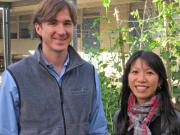Green California Schools Summit
Green California Schools Summit, “Green Schools: More Important Than Ever!”
Pasadena, CA, December 9, 2010

Leaders for the Division of the State Architect (DSA) presented the case for the “grid neutral” school, “a site that produces at least as much electrical energy as it uses in a year.” Supervising Architect Theresa Townsend presented 12 case studies of California public school districts that have aggressively embraced this goal. The Milpitas Unified School District with 14 sites, for example, has installed a 3.4 megawatt solar system with a Power Purchase Agreement that will cover an estimated 75% of annual electric costs. The Irvine Unified USD with 39 campuses and 16 sites that have solar power saves an estimated $8 M annually. And Napa Valley USD estimates that it is now 80% grid neutral. Importantly, Theresa Townsend also reported on CALGreen, the nation’s first mandatory green building code that takes effect in January 2011. The Green Building Code is based on the concept of “grid neutral” and includes both mandatory and voluntary provisions for schools.
As former State Architect David Thorman argues, the potential for energy savings is huge; for example, California community colleges could save annually $9 Million after a 10-year payback and six thousand tons of CO2. His office outlines six steps to achieve a grid neutral school: comprehensive planning, energy efficient design, energy generating technology, innovative funding, energy use management, and well-managed operations and maintenance.
With the passage of Proposition 1D in 2006, California voters authorized $10.42 billion in bond funds for school construction, $7.3 billion of which was allocated for K-12 schools. $100 million was set aside for “high performance schools,” those that seek to adopt green technologies in new construction or modernization projects. In The Grid Neutral Handbook the DSA details the many innovative funding strategies available to schools, including loans (e.g. clean renewable energy bonds), self-funding (e.g. Power Purchase Agreements PPA) and free money (e.g. California solar initiative).
Professionals from two organizations that advocate and facilitate environmentally sustainable schools provided advice on how to transform the school facilities process. Donnie Kenneth, US Green Building Conference Schools Sector Manager, made the case for greening existing buildings: better health, better achievement, less cost. He outlined LEED-EBOM (Leadership in Energy and Environmental Design—Existing Buildings, Operations and Maintenance). With 133,000 schools nationwide, 55 million students, and 20% of the American population engaged in schools every day, the potential for energy savings is huge. The new USGBC Coalition for Green Schools provides a step-by-step process for schools to follow (usgbc.org/k-12 toolkit).

On the curricular front, the California Education and the Environment Initiative (EEI) promises to infuse the state’s K-12 curriculum with 85 environmental education units that have been crafted over a several year period. As Natalie Lee from the Office of Education and the Environment of the state’s Environmental Protection Agency explained, in 2003 the state legislature passed a bill that required California to develop “environmental principles and concepts” that could be incorporated into the K-12 curriculum.
Since then a public-private partnership including the Department of Education, CalEPA, and a host of non-profits and local school districts developed an environmental education curriculum that could dovetail with the state’s standards for history/social sciences and science. The group is now raising funds for a four-year marketing campaign that would bring the curriculum to all 1000 school districts. An open question is how this curriculum might relate to the Environmental Literacy Plan that would be required if the federal No Child Left Inside legislation passes in Congress.
While the conference focused on campus construction and state policy, there were many opportunities to remember the admonition to “think globally, act locally” regarding school initiatives for sustainability. Sara Laimon, founder and director of the Green Ambassadors program at the Environmental Charter High School in Los Angeles, described the transformation in her school when students are empowered to seek change. 









